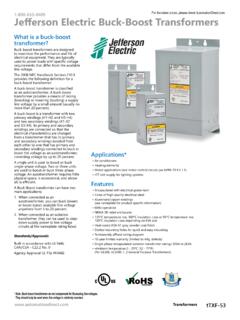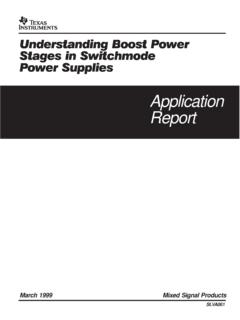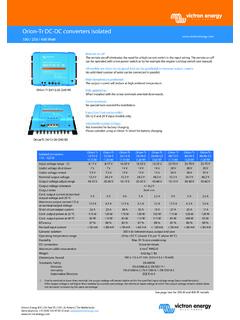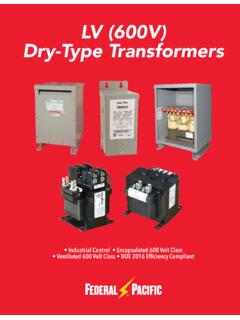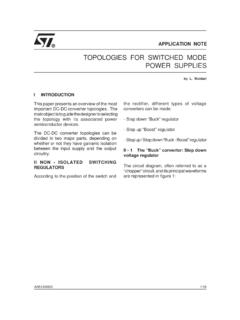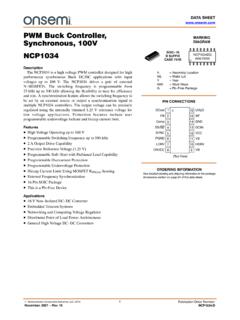Transcription of Buck Converter Design - Mouser
1 Design Note DN 2013-01 January 2013 buck Converter Design Jens Ejury Infineon Technologies North America (IFNA) Corp. buck Converter Design 2 Design Note DN 2013-01 January 2013 Published by Infineon Technologies North America 27703 Emperor Blvd, suite 310 Durham, NC 27703 All Rights Reserved. Attention please! THE INFORMATION GIVEN IN THIS APPLICATION NOTE IS GIVEN AS A HINT FOR THE IMPLEMEN-TATION OF THE INFINEON TECHNOLOGIES COMPONENT ONLY AND SHALL NOT BE REGARDED AS ANY DESCRIPTION OR WARRANTY OF A CERTAIN FUNCTIONALITY, CONDITION OR QUALITY OF THE INFINEON TECHNOLOGIES COMPONENT. THE RECIPIENT OF THIS APPLICATION NOTE MUST VERIFY ANY FUNCTION DESCRIBED HEREIN IN THE REAL APPLICATION. INFINEON TECHNOLOGIES HEREBY DISCLAIMS ANY AND ALL WARRANTIES AND LIABILITIES OF ANY KIND (INCLUDING WITHOUT LIMITATION WARRANTIES OF NON-INFRINGEMENT OF INTELLECTUAL PROPERTY RIGHTS OF ANY THIRD PARTY) WITH RESPECT TO ANY AND ALL INFORMATION GIVEN IN THIS APPLICATION NOTE.
2 Information For further information on technology, delivery terms and conditions and prices please contact your nearest Infineon Technologies Office ( ). Warnings Due to technical requirements components may contain dangerous substances. For information on the types in question please contact your nearest Infineon Technologies Office. Infineon Technologies Components may only be used in life-support devices or systems with the express written approval of Infineon Technologies, if a failure of such components can reasonably be expected to cause the failure of that life-support device or system, or to affect the safety or effectiveness of that device or system. Life support devices or systems are intended to be implanted in the human body, or to support and/or maintain and sustain and/or protect human life. If they fail, it is reasonable to assume that the health of the user or other persons may be endangered.
3 DN 2013-01 Subjects: CCM buck Converter Design Author: Jens Ejury We Listen to Your Comments Any information within this document that you feel is wrong, unclear or missing at all? Your feedback will help us to continuously improve the quality of this document. Please send your proposal (including a reference to this document) to: buck Converter Design 3 Design Note DN 2013-01 January 2013 Table of contents 1 Introduction .. 4 2 buck topology .. 4 3 Modes of Operation .. 4 4 Design Equations .. 6 buck Converter Design 4 Design Note DN 2013-01 January 2013 1 Introduction A buck Converter is the most basic SMPS topology. It is widely used throughout the industry to convert a higher input voltage into a lower output voltage. The buck Converter (voltage step-down Converter ) is a non- isolated Converter , hence galvanic isolation between input and output is not given.
4 2 buck topology The buck Converter (Figure ( buck Converter Basic Diagram) ) is the most popular topology used to distribute power in complex systems, server motherboards, broadband communication boards, etc. It provides the required local voltage from a higher voltage bus that is common to multiple converters in the system. The Converter itself consists of one active switch controlled by an IC, a rectifier and filter elements. This great simplicity allows for cost effective high efficient power distribution throughout the application. The buck Converter has the filter inductor on the output side, which provides a smooth continuous output current waveform to the load. This could be considered a qualitative benefit but requires special considerations for big load transients. The input is exposed to the switch S1. Therefore the input current is a highly dynamic waveform.
5 This is undesired as the switched current emits noise into the entire system. A proper decoupling is inevitable. That is why capacitor C1 is a crucial part of the topology. Figure ( buck Converter Basic Diagram) 3 Modes of Operation The buck Converter can operate in different modes; continuous conduction mode (CCM, fixed frequency and high current) and discontinuous conduction mode (DCM, PFM at low current). Fig. shows modeled waveforms of CCM operation to illustrate the component currents. Fig. shows modeled waveforms of DCM operation respectively. At constant frequency the buck Converter with rectifier diode D1 will at low current always operate in DCM mode because the diode blocks negative current flow. If the diode is being implemented by a synchronous rectifier switch ( MOSFET) the CCM can even be obtained at zero output current at the same fixed frequency.
6 The valley inductor current IVA is then negative. For efficiency reasons many implementations feature pulse frequency modulation (PFM) at low currents. This is a DCM operation at fixed pulse width but variable frequency to minimize switching events and thus to reduce dynamic loss to a minimum. The components are stressed most when the load current is high. Hence the Converter operates in CCM and further considerations will be done with respect to it. buck Converter Design 5 Design Note DN 2013-01 January 2013 Figure (CCM Operation) Figure (DCM Operation) buck Converter Design 6 Design Note DN 2013-01 January 2013 4 Design Equations The following are Design equations for the CCM operated buck . A Design example has been calculated along with the description. Table 1 Specifications Input voltage 12 V Output voltage V Maximum power 120 W Switching frequency 500 kHz Inductor current ripple 30% Output voltage ripple 10 mV Filter Inductor The filter inductor value and its peak current are determined based on the specified maximum inductor current ripple.
7 For the conditions given in Table 1 the inductor value should be: When considering a 10% duty cycle increase for offsetting power loss the equation results: buck Converter Design 7 Design Note DN 2013-01 January 2013 Duty cycle variation based on power losses in high efficiency converters usually has no big impact on the inductor value and can be ignored for inductor selection. Practically a 150nH inductor will have to be chosen. The inductor peak current is then: For the given situation the inductor must sustain a peak current of 77A without showing saturation. It is important that the inductor maintains its inductance at the elevated operating temperature based on board temperature and inductor loss consisting of core loss and DCR loss.
8 A saturating inductor will lead to excessive current in the MOSFETs, impact application reliability or even lead to sudden destruction due to electrical overstress of the MOSFETs. The DCR loss can be approximated from the DCR value at operating temperature: The impact of the ripple current usually can be neglected for the DCR related loss. However, the core loss varies greatly from one material and shape to another one. Hence the inductor core material has to be chosen properly to ensure that the core loss is within specified limits under target conditions. Assuming Milliohm for the DCR the DCR power loss in the inductor will be: This is a rather high DCR loss. A better Design choice will be a 2-phase buck as smaller inductors with lower losses can be used. Any resistive loss in the application scales with the square of the output current and therefore these losses can be greatly reduced by having multiple current paths.
9 For the given example a 2-phase Design leads to a phase current of: For the 2-phase solution the saturation current needs to be 39A. This gives a much bigger selection range for components (active and passive), the Design can be optimized properly. For further Design examples the 2-phase approach will be chosen. Recitifier buck Converter Design 8 Design Note DN 2013-01 January 2013 The rectifier diode D1 encounters a forward conduction loss of: For our example that leads to a diode loss of: One can see from that figure that a synchronous rectifier is inevitable to make this an efficient power Converter . Every Milliohm RDSON in the synchronous rectifier MOSFET accounts for a conduction loss of: . The BSC010NE2LS has a typical RDSON of 1 m at 5 V gate drive voltage.
10 Additional consideration for the synchronous rectifier FET is the reverse recovery loss, dead time loss and the gate drive loss. They all are dynamic properties. The reverse recovery loss is very hard to determine from the datasheet as it has many dependencies. However, in state-of the art switching MOSFETs it is small so that it usually will not play a primary role in the concrete choice of the MOSFET. Some MOSFETs have implemented embedded reverse recovery free structures bypassing the body diode. Those FETs have an advantage on reverse recovery loss at the expense of RDSON per die area. A main criteria for low dead time loss is the driver that controls the gate of switching FET and synchronous rectifier MOSFET with minimum time between them. Dead time loss is directly proportional to the switching frequency: For the example here we assume a switching frequency of 300kHz and a dead time per transition of 10ns.

